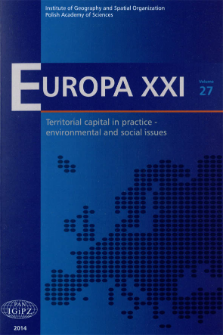- Search in all Repository
- Literature and maps
- Archeology
- Mills database
- Natural sciences
Advanced search
Advanced search
Advanced search
Advanced search
Advanced search

Object
Title: The Roma people in Bulgaria – Their number and localization, from the Liberation (1878) until the beginning of the 21st Century
Subtitle:
Publisher:
Place of publishing:
Description:
Type of object:
Abstract:
The main objective of this study is to trace accurately the changes in the number and in the location of the Roma ethnic group, which has constituted no more than 2% of the population during the whole history ofBulgaria after The Liberation (1878). In this study, general and regional features of the dynamics of demographic processes and spatial distribution of the Roma in Bulgaria have been followed through and some main trends inthe development of these processes have been established.
References:
1. Angelov G., Vankova Z., 2011. Bulgarian labour migration: does it make sense of restrictions inthe EU?, Institute “Open Society”, http://osi.bg/downloads/File/2011_New / bg_trudova_migracia_BG_kor.pdf
2. Council of Europe, 2003. Report submitted by Bulgaria pursuant to article 25, paragraph 1 of the framework convention for the protection of national minorities. Council of Europe: Secretariat of the Framework Convention for the Protection of National Minorities, http://www.unhcr.org/refworld/country,,COESFCPNM,,BGR,,4254ebdb4,0.html.
3. Gening S. 1970. Ethnic process in the primitive. Sverdlovsk: Nauka, 98 pp.
4. Ilieva N., 2009. Application of Geographic Information Systems in Delineating of Regions with Compact Population of a Certain Ethnic Group. Problems of Geography, no. 4, pp. 11-19.
5. Kertikov K. 2002. Europeanization or gypsification of Bulgaria. Balkans'21, no. 1, http://www.balkans21.org/2002_1/euro1.html.
6. Marushiakova E., 1991. Gypsies in Bulgaria and their religion. [in:] V. RUSSANOV (ed.), Proceedings Aspects of ethno-cultural situation in Bulgaria, Sofia: Center for the Study of Democracy, pp. 117-123.
7. Marushiakova E., 1992. Ethnic characteristics of the Roma in Bulgaria. Bulgarian etnnografiya, no. 4, pp. 12-22.
8. Marushiakova E., Popov V., 1993. Gypsies in Bulgaria. Sofia: Club 90, 239 pp.
9. Pamporov A. 2006. Roma Everyday Life in Bulgaria. Sofia: IMIR, 394 pp.
10. Pamporov A., 2008. Ethnic identity. [in:] T. Braikova-Tomova (ed.), Proceedings Roma in Bulgaria, Sofia: Open Society, pp. 11-18.
11. Popov V. 1991. Gypsies in Bulgaria, and their ethnic consciousness. [in:] V. RUSSANOV (ed.), Proceedings Aspects of ethno-cultural situation in Bulgaria, Sofia: Center for the Study of Democracy, pp. 123-128.
12. Tomova I. 1995. Gypsies in the transition period. Sofia: IMIR, 127 pp.
Relation:
Volume:
Start page:
End page:
Detailed Resource Type:
Format:
File size 2,2 MB ; application/pdf
Resource Identifier:
oai:rcin.org.pl:53619 ; 1429-7132 ; 10.7163/Eu21.2014.27.5
Source:
CBGiOŚ. IGiPZ PAN, call nos.: Cz.6406, Cz.6407 ; click here to follow the link
Language:
Rights:
Terms of use:
Copyright-protected material. May be used within the limits of statutory user freedoms
Digitizing institution:
Institute of Geography and Spatial Organization of the Polish Academy of Sciences
Original in:
Projects co-financed by:
European Union. European Regional Development Fund ; Programme Innovative Economy, 2010-2014, Priority Axis 2. R&D infrastructure
Access:
Object collections:
- Digital Repository of Scientific Institutes > Partners' collections > Institute of Geography and Spatial Organization PAS (IGiPZ PAN) > Publications of IGiPZ PAN and employees
- Digital Repository of Scientific Institutes > Partners' collections > Institute of Geography and Spatial Organization PAS (IGiPZ PAN) > Library > Series/Journals/Periodics
- Digital Repository of Scientific Institutes > Literature > Journals/Articles
Last modified:
Oct 13, 2023
In our library since:
May 8, 2015
Number of object content downloads / hits:
1905
All available object's versions:
https://rcin.org.pl./publication/72449
Show description in RDF format:
Show description in RDFa format:
Show description in OAI-PMH format:
Objects Similar
Śleszyński, Przemysław Kubiak, Łukasz Korcelli-Olejniczak, Ewa
Śleszyński, Przemysław
Diachenko, Aleksandr Kruk, Janusz Milisauskas, Sarunas
Adamowicz, Mieczysław
Śleszyński, Przemysław Wiśniewski, Rafał (1977– ) Szejgiec-Kolenda, Barbara
Śleszyński, Przemysław Stępniak, Marcin Mazurek, Damian

 INSTYTUT ARCHEOLOGII I ETNOLOGII POLSKIEJ AKADEMII NAUK
INSTYTUT ARCHEOLOGII I ETNOLOGII POLSKIEJ AKADEMII NAUK
 INSTYTUT BADAŃ LITERACKICH POLSKIEJ AKADEMII NAUK
INSTYTUT BADAŃ LITERACKICH POLSKIEJ AKADEMII NAUK
 INSTYTUT BADAWCZY LEŚNICTWA
INSTYTUT BADAWCZY LEŚNICTWA
 INSTYTUT BIOLOGII DOŚWIADCZALNEJ IM. MARCELEGO NENCKIEGO POLSKIEJ AKADEMII NAUK
INSTYTUT BIOLOGII DOŚWIADCZALNEJ IM. MARCELEGO NENCKIEGO POLSKIEJ AKADEMII NAUK
 INSTYTUT BIOLOGII SSAKÓW POLSKIEJ AKADEMII NAUK
INSTYTUT BIOLOGII SSAKÓW POLSKIEJ AKADEMII NAUK
 INSTYTUT CHEMII FIZYCZNEJ PAN
INSTYTUT CHEMII FIZYCZNEJ PAN
 INSTYTUT CHEMII ORGANICZNEJ PAN
INSTYTUT CHEMII ORGANICZNEJ PAN
 INSTYTUT FILOZOFII I SOCJOLOGII PAN
INSTYTUT FILOZOFII I SOCJOLOGII PAN
 INSTYTUT GEOGRAFII I PRZESTRZENNEGO ZAGOSPODAROWANIA PAN
INSTYTUT GEOGRAFII I PRZESTRZENNEGO ZAGOSPODAROWANIA PAN
 INSTYTUT HISTORII im. TADEUSZA MANTEUFFLA POLSKIEJ AKADEMII NAUK
INSTYTUT HISTORII im. TADEUSZA MANTEUFFLA POLSKIEJ AKADEMII NAUK
 INSTYTUT JĘZYKA POLSKIEGO POLSKIEJ AKADEMII NAUK
INSTYTUT JĘZYKA POLSKIEGO POLSKIEJ AKADEMII NAUK
 INSTYTUT MATEMATYCZNY PAN
INSTYTUT MATEMATYCZNY PAN
 INSTYTUT MEDYCYNY DOŚWIADCZALNEJ I KLINICZNEJ IM.MIROSŁAWA MOSSAKOWSKIEGO POLSKIEJ AKADEMII NAUK
INSTYTUT MEDYCYNY DOŚWIADCZALNEJ I KLINICZNEJ IM.MIROSŁAWA MOSSAKOWSKIEGO POLSKIEJ AKADEMII NAUK
 INSTYTUT PODSTAWOWYCH PROBLEMÓW TECHNIKI PAN
INSTYTUT PODSTAWOWYCH PROBLEMÓW TECHNIKI PAN
 INSTYTUT SLAWISTYKI PAN
INSTYTUT SLAWISTYKI PAN
 SIEĆ BADAWCZA ŁUKASIEWICZ - INSTYTUT TECHNOLOGII MATERIAŁÓW ELEKTRONICZNYCH
SIEĆ BADAWCZA ŁUKASIEWICZ - INSTYTUT TECHNOLOGII MATERIAŁÓW ELEKTRONICZNYCH
 MUZEUM I INSTYTUT ZOOLOGII POLSKIEJ AKADEMII NAUK
MUZEUM I INSTYTUT ZOOLOGII POLSKIEJ AKADEMII NAUK
 INSTYTUT BADAŃ SYSTEMOWYCH PAN
INSTYTUT BADAŃ SYSTEMOWYCH PAN
 INSTYTUT BOTANIKI IM. WŁADYSŁAWA SZAFERA POLSKIEJ AKADEMII NAUK
INSTYTUT BOTANIKI IM. WŁADYSŁAWA SZAFERA POLSKIEJ AKADEMII NAUK




































